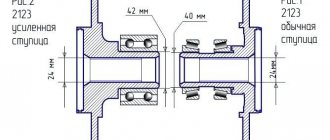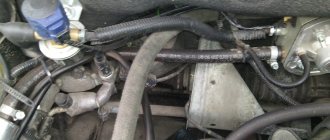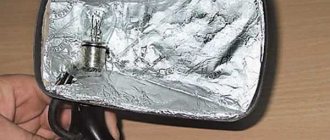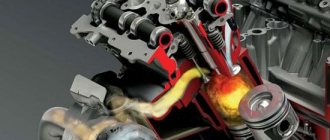Air suspension diagram
Air suspension is used in two cases: to increase comfort and when there is a large difference between the curb and maximum vehicle weights. In trucks, it is built into a complex pneumatic circuit along with brakes ( ZR, 2012, No. 7 ). For passenger cars, the system includes body level sensors, a tank receiver for storing prepared air, a compressor with a dryer and a temperature sensor, an electronic control unit, solenoid valve blocks, as well as the pneumatic elastic elements themselves. The air movement pattern is simple. The compressor sucks it in from the atmosphere and, driving it through a dryer, fills a receiver with a capacity of 5–10 liters. Here it is stored under pressure, reaching 20–23 bar during operation. To get rid of moisture, absorbent granules are used.
Application of air suspension
The simplest pneumatic systems (which, by the way, does not mean cheap) can only be installed on the rear axle. Often such solutions can be found on station wagons and large crossovers. The system assumes periodic increased load on the rear axle, so it adjusts the ground clearance and suspension stiffness depending on the load. Basically, such schemes work in tandem with the Multilink multi-link, but can also be used with MacPherson struts. Moreover, such an air suspension allows you to “lower” the car as much as possible, which greatly simplifies loading and unloading.
Mercedes air suspension control buttons
However, most often pneumatics are installed on all four wheels. This makes it possible to more flexibly control clearance. This design is used not only on expensive crossovers, but also on sports cars, where every millimeter of ground clearance will affect aerodynamics and, as a result, speed and handling.
In recent years, the design of air suspension has become increasingly reliable, which makes it possible to install it not only on expensive cars in the premium segment. The use of air suspension allows you to make driving more dynamic, increase the smoothness of the ride and the level of comfort. This is achieved due to the ability to change the position of the body and the degree of damping of the shock absorbers.
Advantages
For the sake of this characteristic, many people overpay that much money for installing air suspension. But comfort is not the only advantage of this system. If we talk about commercial vehicles, installing air suspension allows you to increase the load capacity without harming the chassis. And the load itself, thanks to the pillows, will remain intact, since the springs dampen vibrations more rigidly.
The next plus is the high stability of the car on the road. Many. It allows you to eliminate rolls when cornering. This can also be done on a spring suspension by clamping the travel of the shock absorbers. However, driving comfort will remain in question.
Another plus is the ability to adjust the clearance. Usually this is a range of 10-15 centimeters. The driver will not have to cut or extend springs to achieve specific ride characteristics. All this changes in a matter of seconds, right from the salon.
Characteristic
So what is air suspension? This is a type of suspension that regulates the position of the body relative to the road due to elastic elements. Air cylinders are used as the latter. In fact, this is one of the main components of this system. Where is this suspension used? It is usually installed on expensive versions of SUVs and sedans. At the moment, air suspension can be found on Volkswagen Touareg, Audi Ku-7, BMW 7 Series, Lexus LS and others. Along with this, the air system is also installed on commercial vehicles. These are truck and mainline tractors from Volvo, Scania, MAN, Iveco and many others. This system is also used on trailers and semi-trailers (including Kegle and Schmitz).
Design
The main component of the air suspension is elastic rubber cushions (cylinders). They are installed instead of elastic suspension components - springs or leaf springs, while other suspension components remain unchanged - levers, shock absorbers.
Pneumatic springs can be a separate component in the suspension, or they can be part of a shock-absorbing strut (on a MacPherson suspension), but in this case the strut is called pneumatic. The compressed air with which the cushions are filled plays the role of an elastic element - it absorbs the oscillatory movements received by the wheel from the road. Due to the physical property of gases to compress, vibrations are absorbed, which the shock absorber then dampens.
Since the pillows are elastic, when filled with air, they change their length. Thanks to this, it is possible to adjust the clearance.
For the correct functioning of the cylinders, the design of the air suspension includes a number of other components. The simplest air suspension consists of:
- pneumatic cylinders on all wheels (separate or as part of pneumatic struts);
- compressor;
- receiver;
- dehumidifier;
- solenoid valve block;
- control systems;
- connecting tubes;
This type of air suspension can be purchased separately and installed on any car.
On which car can air suspension be installed?
According to the experience and assurances of the experts, it is possible to install air suspension on almost any vehicle, since essentially only the metal spring itself changes. The main thing is to choose an air suspension based on the car and the owner’s wishes, based on the further operation of the car. The main disadvantage of air suspension is installation; its price is quite high. The only way to save money is to do the work yourself.
Article on the topic: What to do if your car is stolen
Variety of species
Types of car air suspension
If your car did not have a factory air suspension, but you have a desire to install the air suspension yourself, then it will be important to study the variety of air suspensions. So, the main types of air suspension:
- single-circuit. Designed for one circuit (axle), the pressure in both axle pads will be the same;
- double-circuit on two axes. Similar to single-circuit ones, they are simply installed on both axles of the car, allowing you to adjust the front and rear of the car;
- double-circuit on one axis. Allows you to adjust all four wheels separately;
- four-circuit. The most optimal, expensive and functional type of air suspension.
It is worth understanding that the cost of an air suspension kit will depend not only on its type, but also on the class of vehicle on which it will be installed.
Pros and cons of modern air suspensions
Since air suspensions are installed on a limited number of foreign car models, many car owners would be interested to know what advantages cars equipped with these systems have. And there are quite a lot of them:
- changeable settings, that is, the ability to adjust the clearance value in a certain range. By changing the height of the car above the road, we simultaneously adjust the stiffness of the suspension. For machines equipped with conventional spring elements, a similar operation is possible, but only by replacing the springs themselves. Agree, this can hardly be called a solution. Note that the use of stiff, shortened springs really gives excellent results on a flat, compacted road, significantly improving handling. But at the same time, comfort fades into the background - if you find yourself on an area with an uneven surface, you will turn the trip into torture. Installing soft and elongated springs will make off-road driving comfortable, but on the highway the car will behave unpredictably. By using air suspension, all of the above problems can be avoided. The driver has the ability to lightly press the corresponding button to switch from hard to soft suspension. In other words, the required compromise is achieved depending on the specific road situation;
- excellent handling is one of the main advantages of air suspension. This is especially evident when cornering at high speed, when even with a small turning radius, a noticeable roll of the car is felt. The air suspension is able to compensate for the difference in the position of the wheels above the road surface. For a spring suspension, one can only dream of such a mode. True, it should be noted that the absence of roll does not mean the absence of centrifugal force during cornering;
- customization options. Since no two people are alike, each driver has his own driving style and his own preferences regarding the handling of the car. And if we take into account that in most cases, in addition to the driver, there are also passengers in the car, then changing the load will help improve the car’s handling;
- a means of achieving exclusivity. For most car owners, the bravado of being able to change the ground clearance is unacceptable, but there is a category of drivers for whom this is a vital necessity. They will spare no expense to transform their four-wheeled friend;
- Air suspension has been used on trucks for a long time and very successfully. The capabilities provided by such a system in terms of carrying capacity cannot be overestimated. Typically, changes in the degree of load on the wheels have virtually no effect on the driving characteristics of commercial vehicles. Recently, both minivans and pickups have been equipped with air suspension. For these vehicles, congestion levels can indeed vary greatly even within a single trip;
- Finally, one cannot fail to note the excellent performance characteristics of the air suspension, demonstrated at subzero temperatures. This is achieved through the use of rubber elements in the production of air cushions, which have good elasticity regardless of weather conditions. Thus, it is possible to increase the service life of the air suspension.
Considering such an extensive list of advantages, it seems strange that air suspensions have not yet become widespread. This unfortunate fact becomes clear if you know the main disadvantages of pneumatic damping systems:
- Almost zero maintainability. Regardless of what exactly has become unusable, this unit will not be restored. And the cost of air suspension is an order of magnitude higher than that of other types of systems. So the improved comfort achieved at such a high price is unacceptable for most car owners;
- negative temperatures are another scourge of such systems, although the air spring itself hardly suffers from severe frosts. But other components can easily fail;
- road reagents used to combat icy conditions can just as easily lead to the inoperability of the air suspension, which reacts very sensitively to such chemically active substances.
Having carried out a comparative analysis of both lists, we can come to the conclusion that air suspension is the prerogative of only a small number of cars, whose owners are willing to sacrifice significant sums in order to achieve maximum comfort. In Russian off-road conditions, this would be useful for many drivers, but high cost and harsh winters are an obvious limiting factor on the path to mass distribution of pneumatic suspension.
Components and operating principle
The compressor is a key element of the air suspension, since this unit provides the supply of compressed air.
This is a simple design unit driven by an electric motor. The receiver is a compressed air storage device. Thanks to this unit, the air suspension can quickly be reconfigured - change the ground clearance. The receiver and the compressor are connected not only by pipes, but also by a control system to ensure that the air pressure in the receiver is maintained automatically. To do this, pressure sensors are installed in the storage tank, thanks to which the control system determines the amount of air and replenishes it at high flow rates by turning on the compressor.
Since the compressor pumps air from the environment, the air suspension design necessarily includes a dehumidifier that removes moisture.
The electric valve block regulates the air supply to the pillows depending on the set mode. There is one solenoid valve for each cylinder. Electrovalves operate from signals coming from the control system.
In simple air suspensions (amateur ones, which are bought at a car accessories store), the control unit is presented in the form of a remote control installed on the dashboard. Using this remote control, the driver controls the degree of filling of the compressed air cylinders. But this design does not implement an automatic mode for maintaining body level. That is, the driver inflates the airbags to the required mode and operates the car. The only thing that is possible with this design is to set the required ground clearance on the move.
This type of air suspension works very simply - after starting the engine, the compressor starts up and pumps air into the receiver. After filling to the required pressure, the driver sends signals to each of the electric valves using the remote control, so air fills the air cylinders - the car rises. After shutting off the air supply, the filled cushions keep the body at the desired level.
We do everything ourselves
Rear air suspension with homemade mount
Before installing air suspension on a passenger car, be sure to check whether everything you need is available:
- pneumatic cushions that will replace springs;
- air injection compressor;
- air suspension receiver;
- sensors that will monitor the pressure inside the system and the clearance height;
- air suspension control unit, it will manage and monitor the operation of the sensors and the system as a whole;
- pressure gauge
Please note that the installation instructions for the device must be strictly followed. It is best to order fasteners for the suspension from a turner, adjusting them to match the “native” ones for the car. This will allow you to reinstall the old suspension if necessary. To get job satisfaction when installing air suspension yourself, remember a few important points:
- The air spring must be as strong as possible, since it is on it that the weight of the car rests. Also be sure to check its tightness;
- you cannot do without a receiver, otherwise you will have to use a high-power air suspension compressor, and this is fraught with high energy costs;
- choose the right type of suspension.
What is "pneumatics"
Of course, modern high-quality shock absorbers make driving a car with a classic suspension quite comfortable, but that’s probably all that can be said about the “classic”. No matter how elastic the springs and springs of such a suspension may be, the entire structure retains a high degree of rigidity. This means that the ground clearance (the distance between the bottom and the road surface) of a car equipped with a classic suspension remains unchanged.
This element was developed and put into operation to provide the driver with a greater degree of convenience and a high level of safety while driving.
Air suspension has become widespread on car trailers and truck-type equipment.
However, business-class passenger cars are also often equipped with “pneumatics” - this gives the model a special status and attracts the attention of those who value safety and convenience, while having the opportunity to purchase such a car.
Flaws
There are not many disadvantages, but they are significant. The first drawback is low maintainability. This is especially true for the front suspension. If the pneumatic struts fail, they are replaced entirely. Cylinders cannot be restored in case of leaks.
So, we found out what air suspension is and what its main features are.
Air suspension is a type of car suspension that has the ability to adjust the ride height. It can be adjusted automatically or forcibly, but without the use of human physical force.
Where did air suspension come from?
It turns out that more than 70 years ago pneumatic elements in suspension parts were used on trucks and semi-trailers. Recently, the use of air suspension on passenger cars has become quite popular practice. And on the streets you can often find 20-30 year old examples of mostly French cars, for example Citroen, with hydropneumatic suspension. But it’s not uncommon these days not only for the factory installation of this type of suspension. In the countries of the former Great Union, you can see domestic cars with modified suspension; craftsmen also manage to install pneumatic elements on them.
What is the difference between air suspension and conventional suspension?
In addition to air springs, the design of the car uses a supercharger compressor, a receiver (a reservoir for compressed air) and air distribution systems. Air is supplied and discharged into the cushions using valves. All processes are controlled by the control unit. The characteristics of the compressor and its power, as well as the diameter of the valves and other characteristics are selected individually for each model.
The main and fundamental difference between an “air-pumped” suspension and a spring suspension is the absence of metal springs in its design. Their role is played by air bags. And the owner of a car with air suspension has the opportunity to regulate the driving performance of the car by changing the pressure in those very airbags, essentially the stiffness and height.
What is the advantage of air suspension?
Tastes could not be discussed. And since not all automakers use air springs in the design of their models, we will highlight its most important qualities.
- Changeable settings. Essentially, this is the ability to adjust the ground clearance over a fairly wide range. Thereby changing the height of the car and the stiffness of the suspension. After all, simply replacing springs with harder/softer or lower/higher ones may not give the expected result in terms of driving characteristics. In addition, changing the height and stiffness of the springs inevitably tilts the car in a certain direction of use, making it narrowly targeted.
By the way, short and stiff springs perform well on good asphalt, improving handling. But the suspension becomes too rough and in some cases driving on broken roads turns into torture. And long and soft springs are good on off-road and bad asphalt, but this negatively makes the car a kind of lump with loose steering. Everything in moderation, of course, but any replacement pulls the blanket in its favor to one degree or another.
With air suspension there is simply no such problem. In cars where air bags are installed instead of springs, the driver has the right to choose any available height and stiffness of the suspension. Which does not entail discomfort and does not force you to seek compromises. With it, you can select the required level of rigidity on any surface.
- Excellent handling. One of the characteristics of air suspension is its progressive compression. In other words, the more the air spring is compressed, the more pressure is created in it, increasing rigidity. That is, it is quite difficult to “break through” the air suspension to the bump stop. And the ability to regulate pressure gives the driver enormous opportunities to customize the driving characteristics of the car. Cars with air suspension are characterized as more stable on the road and capable of less roll compared to cars with spring suspension.
- Extensive customization options. Each driver has his own preferences and views on car handling. In addition, the car does not always have one driver. Passengers can also sit in the car, thereby loading the suspension and changing its behavior on the road. All these nuances and differences can be easily leveled out by the air suspension. Therefore, the driver can easily adjust the suspension to suit himself, his driving style, load and degree of workload.
- Individuality and practicality. Those who like to attract attention can lower or raise their car to its extreme position. For many, this is the decisive factor in converting their car.
- It’s not for nothing that air suspension has been used on trucks for a long time. The capabilities it gives the car in terms of carrying capacity cannot be overestimated. And this practically does not change the driving characteristics of the car. This advantage is very important for owners of pickup trucks and minivans, where the level of congestion often varies greatly.
- The air suspension performs well when used in severe frosts due to the use of elastic rubber elements.











